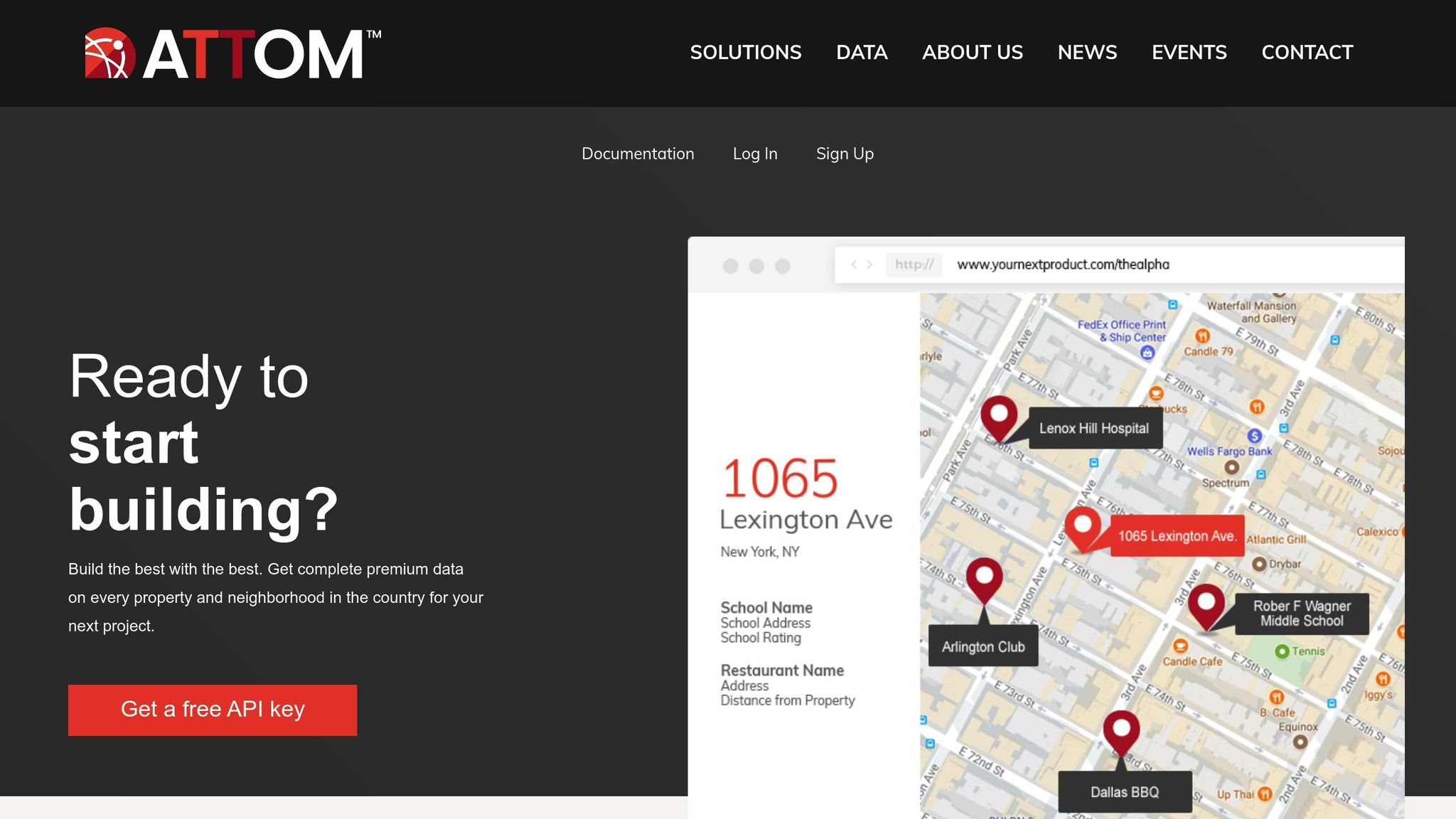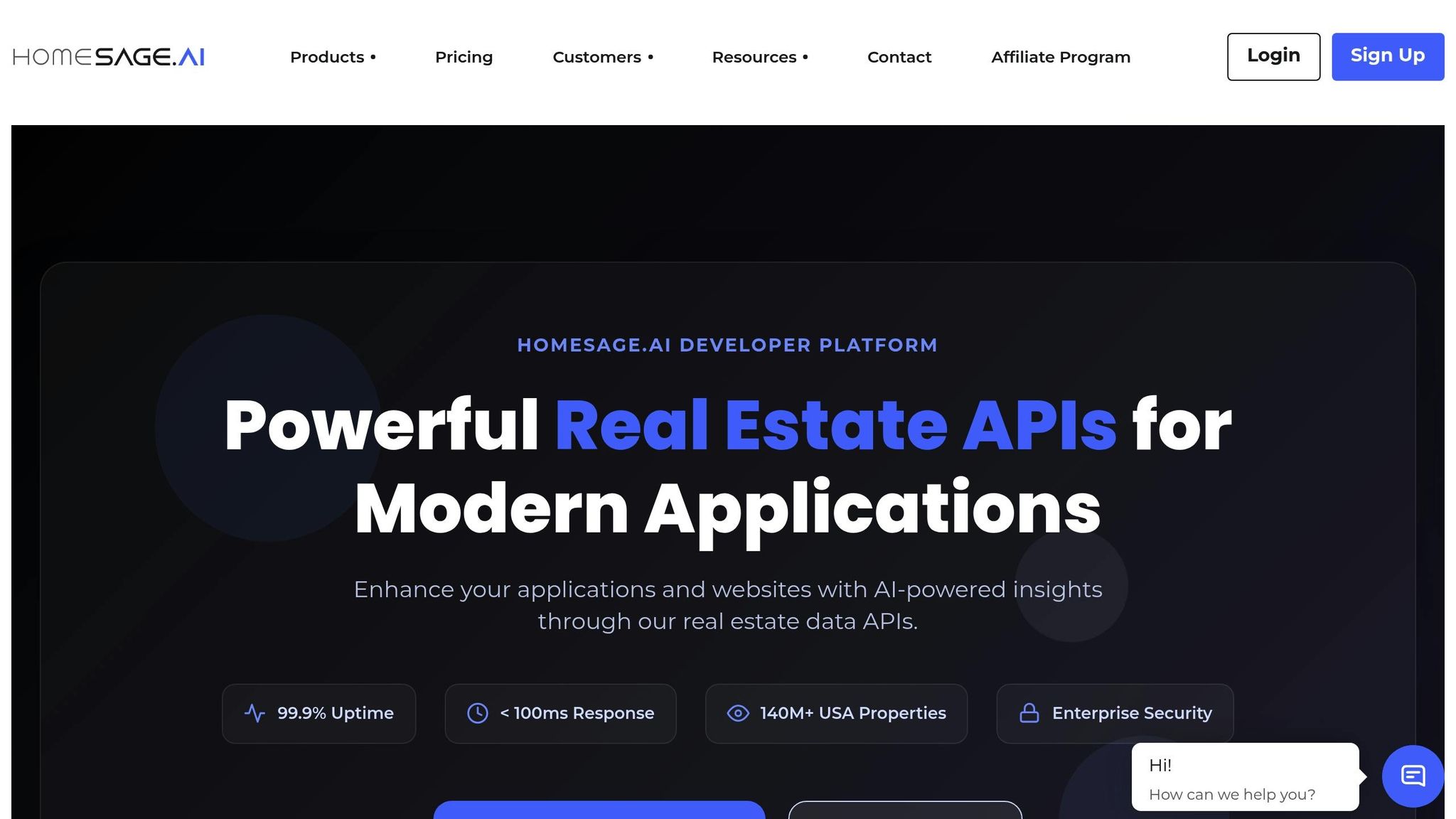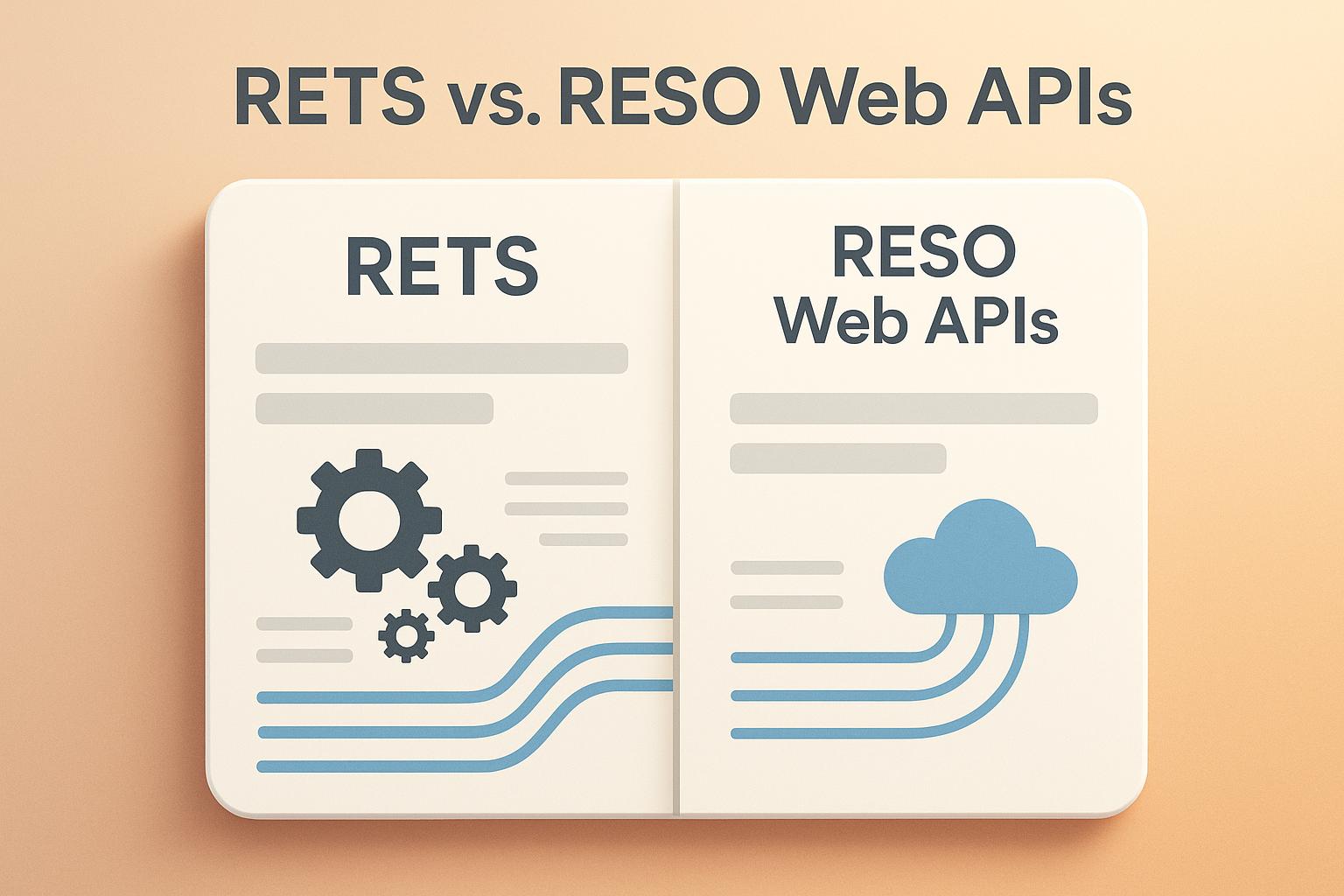In 2025, real estate APIs have become critical tools for property professionals, streamlining access to data like valuations, ownership history, and market trends. These APIs save time and improve decision-making by delivering detailed property insights instantly. Here’s a quick look at the top APIs:
- BatchData API: Offers property and contact data with pay-as-you-go pricing, ideal for flexible needs.
- ATTOM Data API: Provides a massive property database with advanced analytics, suited for enterprise users.
- Zillow API: Focused on consumer-friendly features like Zestimate property valuations.
- Homesage.ai API: Uses AI to analyze property images for investment insights.
- Datafiniti Property Data API: Covers residential, commercial, and industrial properties with daily updates.
Top 5 Real Estate APIs in 2025
Quick Comparison
| API | Key Features | Pricing Model | Best For |
|---|---|---|---|
| BatchData API | Property & contact data, skip tracing | Pay-as-you-go | Flexible, project-based work |
| ATTOM Data API | Extensive database, risk assessments | Custom/Enterprise | Large-scale enterprises |
| Zillow API | Consumer tools, Zestimate valuations | Free/Restricted | Consumer-focused apps |
| Homesage.ai API | AI-driven insights, ARV calculations | Subscription-based | Investors, AI enthusiasts |
| Datafiniti API | Broad property coverage, JSON format | Custom | Data-heavy applications |
Each API serves different needs, from consumer-facing tools to enterprise-level solutions. Choose based on your data requirements, budget, and integration capabilities.
1. BatchData API

BatchData is a powerful real estate data platform that combines detailed property information with tools to enhance contact data. It’s designed to help real estate professionals access property insights while also connecting with property owners and potential leads.
Data Coverage
BatchData provides extensive data on both residential and commercial properties across the United States. It includes ownership details, property characteristics, tax assessments, and historical sales data. The API presents this information in standard U.S. formats, such as square footage, dollar valuations, and USPS-compliant addresses. Users can dive into specifics like lot size, building details, zoning classifications, and neighborhood demographics – all available for properties in all 50 states. This broad data coverage forms the backbone of BatchData’s functionality.
Key Features
BatchData’s features are tailored to simplify property research and streamline outreach efforts:
- Property Data Enrichment: Users can search by address, parcel number, or owner name to retrieve in-depth property profiles. These profiles include market values, ownership history, and physical property details.
- Contact Enrichment and Skip Tracing: This feature helps users find contact information for property owners, such as phone numbers and email addresses. It’s especially useful for real estate investors, agents, and wholesalers aiming to connect with sellers.
- Property Search API: Developers can integrate property search capabilities into their apps, filtering properties by criteria like price range, property type, location, and ownership details.
- Phone and Address Verification: These services ensure the accuracy of contact data, helping users maintain clean records and improve the success of outreach campaigns.
These tools are particularly valuable for real estate professionals who rely on efficient property analysis and direct communication to drive their business.
Pricing Model
BatchData uses a pay-as-you-go pricing structure, which charges users based on the data they consume. This approach is ideal for businesses with varying data needs, such as seasonal operations or project-based work, as it eliminates the commitment of monthly fees.
For larger companies or those with unique data requirements, BatchData offers custom pricing solutions. These can include bulk data delivery, tailored datasets, and professional services like data integration and consulting to meet specific business goals.
Integration Options
The BatchData API supports easy integration through RESTful endpoints, making it compatible with CRMs, investment platforms, and custom applications. Users can automate property research and incorporate contact enrichment directly into their existing workflows.
For organizations needing extra support, BatchData provides professional services to assist with data integration, strategy development, and technical setup. These services ensure that businesses can fully leverage the platform and seamlessly incorporate it into their operations.
Limitations
While BatchData provides extensive property and contact data, it’s important to evaluate whether its offerings align with your specific needs. For example, the pay-as-you-go pricing might lead to higher costs for users with consistently high data demands compared to subscription-based models. Additionally, its robust contact enrichment tools may be unnecessary for those focused solely on property analysis rather than outreach. Understanding these factors can help professionals determine if BatchData is the right fit for their objectives.
2. ATTOM Data API

The ATTOM Data API offers a treasure trove of property intelligence by pulling together information from a wide range of sources like assessor offices, MLS, brokers, and third-party providers. Its goal? To create a unified data ecosystem that simplifies property research and analysis. Here’s a closer look at what ATTOM brings to the table.
Data Coverage
ATTOM’s database is massive, with over 158 million property records covering 99% of the U.S. population. It holds 70 billion rows of data with 9,000 attributes per property, making it one of the most detailed real estate data platforms out there.
The platform provides insights at both the property and neighborhood levels. For individual properties, you’ll find ownership details, automated valuation models (AVMs), mortgage info, sales history, property characteristics, tax assessments, zoning classifications, and land use data. On a broader scale, it delivers neighborhood demographics, school ratings, crime stats, climate risks, and even local points of interest.
Another standout feature is its financial and risk data. ATTOM offers access to property tax records, deed information, mortgage details, foreclosure data, and assessments of environmental and natural hazard risks. This makes it a go-to resource for anyone involved in risk evaluation or large-scale market analysis.
Key Features
ATTOM simplifies the process of working with property data by offering standardized datasets through unified APIs. This means developers can focus on creating applications instead of wrestling with data integration headaches.
The platform also provides historical time-series data and foreclosure information, which are perfect for trend analysis and spotting distressed properties. This level of detail helps real estate professionals make faster, smarter decisions.
Designed with large organizations in mind, ATTOM serves enterprises, analytics firms, and government agencies that need property intelligence for compliance, risk evaluation, or market research. While its raw data is ideal for AI and machine learning projects, ATTOM doesn’t position itself as an AI-first platform.
Pricing Model
ATTOM uses a custom/enterprise pricing model, so you’ll need to contact their sales team for a quote. They offer subscription-based plans as well as per-call pricing, giving companies flexibility based on their specific needs.
Trial access is available, but the pricing structure is usage-driven. This enterprise-focused approach might be a challenge for smaller companies or startups, as the costs and integration demands can be a bit steep.
Integration Options
The ATTOM Data API relies on REST architecture and supports both JSON and XML formats. This makes it compatible with a variety of development environments and existing real estate platforms.
That said, the API has a 200 calls per minute limit, which can slow down projects requiring rapid data processing or real-time searches. For organizations handling large datasets, this limitation requires careful planning and may extend processing times.
ATTOM also offers flexible data delivery solutions, making it a fit for applications aimed at buyers, sellers, and investors. While its standardized formats simplify integration, the technical complexity is better suited for enterprise-level applications.
Limitations
ATTOM’s focus on enterprise-level clients comes with some challenges. The 200 calls per minute limit can be a bottleneck for apps needing quick, large-scale data processing.
Additionally, its custom pricing model and reliance on direct sales contacts can slow down onboarding compared to platforms with self-service options. Smaller businesses or individual developers might find the platform less accessible due to these hurdles.
While its raw data is well-suited for AI projects, ATTOM doesn’t offer advanced AI tools or a developer-friendly experience. If your needs are more straightforward, like basic property lookups, you might find ATTOM’s depth more than you actually need.
3. Zillow API

Zillow’s API ecosystem provides developers with access to one of the largest and most well-known real estate platforms in the U.S. With data on approximately 100 million properties, Zillow offers a versatile suite of APIs that cater to everything from property valuations to mortgage rates. However, its focus on consumer-friendly features often comes with trade-offs in terms of raw data access.
Data Coverage
Zillow’s APIs span the entire real estate lifecycle, delivering tools for buyers, sellers, renters, and mortgage professionals. The Zestimate API provides automated property valuations for nearly 100 million U.S. properties. This vast coverage is ideal for applications requiring nationwide property valuation data.
The Property Details API goes deeper, offering specifics like the number of bedrooms and bathrooms, square footage, property type, and even unique features. For those needing broader insights, the Public Data APIs include access to public records, neighborhood demographics, and local real estate trends.
For mortgage professionals, Zillow’s Mortgage APIs deliver up-to-date rates, lender reviews, and lead management tools. Developers focused on rental markets can leverage the Rentals APIs, which include lead management features and feed integrations. This comprehensive data structure allows developers to create applications that cater to a wide range of real estate needs, all from a single platform.
Key Features
Zillow’s APIs are designed with specific use cases in mind, prioritizing functionality over raw data dumps. The Search API enables location-based searches with flexible filters for pricing and other criteria. Meanwhile, the Transactions API simplifies deal management and supports interactive features through the Tech Connect API.
For real estate agents, the MLS & Broker Listings APIs provide tools for managing listings, tracking performance, and integrating direct feed programs. Zillow also enhances user experience with features like data visualizations, maps, and photos, making property search applications more engaging.
The Tech Connect API is particularly noteworthy for its two-way integration, allowing developers to not only pull data but also update listings and manage user preferences. This capability is especially useful for creating interactive and dynamic applications.
Integration Options
Zillow’s APIs are built on a REST architecture and support both JSON and XML response formats, making them accessible to most developers. Authentication methods vary depending on the API, with newer services like the Tech Connect API using OAuth 2.0, while older APIs still rely on a ZWSID (Zillow Web Services ID).
Developers can find support for multiple programming languages. For instance, Python libraries such as httpx and xml.etree.ElementTree are commonly used, while JavaScript is a popular choice for web applications. Even non-technical users can integrate Zillow data into tools like Google Sheets using add-ons like Apipheny.
For more advanced integrations, Zillow’s Partner APIs offer tailored solutions for mortgage lenders and real estate professionals, often requiring a partner ID for access. Real-time updates are supported through polling or webhooks, ensuring applications stay current with market changes. However, these tools are more consumer-oriented, which may pose challenges for developers working on data-heavy applications.
Limitations
While Zillow’s APIs are robust, they come with notable limitations. Public APIs are restricted and unsuitable for large-scale data collection. Developers often turn to web scraping or reverse-engineering internal APIs to fill gaps, but these methods violate Zillow’s terms of service and carry significant risks.
The platform’s focus on consumer experience means that APIs prioritize user-facing features over bulk data access. For developers needing extensive market data or tools for large-scale analysis, these limitations can be a significant hurdle. Rate limiting and access restrictions further constrain the ability to use Zillow’s APIs for enterprise-level applications.
Another drawback is Zillow’s U.S.-centric approach. The APIs primarily serve the domestic market, making them less useful for international real estate applications. Additionally, the emphasis on consumer-friendly features may not align with the needs of institutional investors or analytics firms that require more granular and unrestricted data access.
sbb-itb-8058745
4. Homesage.ai API

Homesage.ai combines the power of AI and computer vision to transform raw property data into actionable insights for real estate investors.
Data Coverage
Homesage.ai delivers detailed insights on over 140 million residential properties across the United States. With daily updates from both off-market sources and MLS listings, users gain access to some of the most current and accurate property information available. Impressively, Homesage.ai is the first company to apply computer vision models to every new listing in the U.S.. This technology automatically calculates key investment metrics like comparable sales (comps) and after-repair values (ARV), helping investors spot properties with equity potential.
One satisfied user, Robert H., shared:
"I’m not sure how they do it, but the comps are on point and the after-repair values are accurate."
The platform also provides insights into remodeling projects that could boost property values, giving investors a competitive edge in decision-making.
Key Features
Homesage.ai’s API uses AI and computer vision to extract insights directly from property images. This allows for automatic calculations of essential metrics, such as ARV and comps, to identify properties with strong equity potential. These features equip investors with precise, data-driven tools to navigate the market more effectively.
Integration Options
Homesage.ai offers well-documented Real Estate APIs that integrate effortlessly into existing websites and platforms. Designed with IT developers in mind, the setup process is simple: select a plan and activate the API product. For clients who prefer a more hands-off approach, Homesage.ai provides free integration services to ensure everything runs smoothly.
Jorge M., a developer from Washington, DC, highlighted the ease of use:
"I use Homesage.ai’s APIs to seamlessly enhance my clients’ websites with powerful real estate insights. The integration is smooth, and the results have been impressive."
For businesses with in-house development teams, the platform supports self-managed integrations, offering flexibility to meet specific technical needs. This adaptability makes Homesage.ai a valuable tool for modern real estate workflows.
5. Datafiniti Property Data API

The Datafiniti Property Data API offers a wealth of property data spanning residential, commercial, and industrial sectors, with daily updates to ensure accuracy and relevance.
Data Coverage
Datafiniti’s database contains an impressive array of real estate information across the United States. It includes details on over 122 million single-family homes, 27.8 million apartments, 27.2 million townhomes and condos, and 6.2 million commercial, industrial, and retail properties.
This API provides access to a wide range of property details, including ownership history, tax assessments, and geographical data. Professionals can use this information for various purposes such as market analysis, property valuation, investment decisions, sales strategies, marketing campaigns, underwriting, lending, risk management, site selection, and fraud detection. The extensive data coverage makes it a versatile tool for real estate professionals.
Key Features
The Datafiniti Property Data API is designed to cater to diverse needs, from simple property lookups to complex market analysis and risk assessments. Its broad utility lies in supporting informed, data-driven decisions across different real estate sectors.
To make integration seamless, the API delivers data in widely used formats like JSON and CSV, allowing businesses to incorporate property data into their existing workflows and analytical tools with ease.
Integration Options
Datafiniti ensures smooth integration into various systems, offering flexibility for different technical setups. The API is built on a REST architecture and supports popular development tools and libraries, including Postman, cURL, Node.js, PHP, and Python.
For WordPress users, Datafiniti has tailored integration through the WPGetAPI plugin. By March 2025, developers can install the plugin and configure a Datafiniti API endpoint by setting the Base URL to https://api.datafiniti.co/v4/properties/search/. Headers should include Content-Type: application/json and Authorization: Bearer <your_API_key>. Once configured, the plugin enables property data retrieval for creating automated WordPress posts.
Python developers can retrieve their API token from the Datafiniti Web Portal and use the ‘requests’ module to integrate the API into their applications seamlessly.
"This guide walks you through the process of integrating Datafiniti’s API with the WPGetAPI plugin to automatically create WordPress posts. WPGetAPI enables direct API calls from WordPress and can transform API responses into posts."
- Datafiniti Documentation
Authentication requires an API key, which can be accessed via the Datafiniti Web Portal. To ensure smooth integration, the platform provides detailed guides for various programming environments.
Pros and Cons
When it comes to choosing the right API for your business, understanding the strengths and limitations of each option is essential. Here’s a breakdown to help you make an informed decision:
| API | Pros | Cons |
|---|---|---|
| BatchData API | • Flexible pay-as-you-go pricing • Advanced property and contact data enrichment • Skip tracing capabilities • Phone and address verification • Custom datasets and professional services • Easy integration for developers |
• No major drawbacks identified |
| ATTOM Data API | • Extensive nationwide property database • Historical sales data and market trends • Automated valuation models (AVMs) • Property risk assessments • Strong market presence • Multiple data delivery formats |
• Expensive enterprise features • Complex pricing tiers • Steep learning curve for advanced tools • Rate limits on lower-tier plans |
| Zillow API | • Popular consumer brand • Zestimate property valuations • Active listing data • Free tier available • Simple integration for basic use |
• Limited commercial use permissions • Restricted data for competitors • Frequent API updates and deprecations • Consumer-focused, not enterprise-grade • Geographic limitations in some areas |
| Homesage.ai API | • AI-driven property insights • Predictive analytics • Modern machine learning algorithms • Real-time market analysis • Competitive pricing • Focus on accuracy |
• Smaller data coverage compared to established players • Limited historical data • Newer technology with less proven reliability • Fewer integration examples and community resources |
| Datafiniti Property Data API | • Massive database: 122+ million single-family homes • Daily updates for accuracy • Supports residential, commercial, and industrial properties • JSON and CSV output formats • REST API with multi-language support • WordPress plugin integration |
• High complexity for simple use cases • Requires technical expertise for full functionality • Limited support documentation • Possible data quality inconsistencies across regions |
This table highlights the unique strengths and challenges of each platform, helping you align the right tool with your goals. Factors like pricing models, data coverage, ease of integration, and target users vary significantly across these APIs.
BatchData stands out with its flexible pay-as-you-go pricing and developer-friendly design, making it a great choice for businesses with variable data needs. On the other hand, ATTOM Data offers a robust property database and advanced analytics, though it comes with a steeper price tag and a more complex setup.
If you’re looking for consumer-friendly features, Zillow provides free access and easy integration for basic needs, but its restrictive usage policies may not suit professional applications. Meanwhile, Homesage.ai focuses on AI-powered insights and real-time analytics, appealing to tech-savvy firms, though its coverage is more limited compared to older players.
For those needing massive data volume, Datafiniti delivers with over 122 million single-family homes and daily updates. It also offers technical flexibility with multi-language support and WordPress plugin options, though its complexity might require more technical expertise.
Ultimately, your choice will depend on the specific needs of your real estate projects – whether it’s advanced analytics, massive data coverage, or AI-driven insights. Each API has carved out its niche, providing options for everything from consumer-focused applications to enterprise-level solutions.
Conclusion
Selecting the best real estate API in 2025 comes down to aligning it with your business goals and operational scale. For instance, BatchData stands out with its advanced property data enrichment and skip tracing, offered through a flexible pay-as-you-go model. It’s just one example of the many options available, each catering to different needs.
Other platforms bring unique strengths, such as varying data coverage, pricing structures, and integration features. To make the right choice, take the time to assess these options against your specific requirements.
As you review your choices, consider your technical resources and budget. Starting with a trial or a flexible plan can help ensure the API integrates smoothly with your systems before making a long-term commitment.
FAQs
How can I choose the best real estate API for my business in 2025?
Choosing the right real estate API for your business in 2025 starts with clearly identifying your goals and needs. One of the first things to assess is data coverage. Does the API provide the level of property data you require – whether local, national, or global? Make sure it includes both residential and commercial markets, and check if historical data is available for analyzing trends over time.
Another key factor is the features and data types the API offers. Beyond basic property information, look for advanced tools like analytics, visualizations, and predictive insights that can help you make smarter, data-driven decisions. Also, consider how easily the API integrates with your current systems, such as your CRM, and whether it supports formats like Excel for smooth data exports.
Lastly, take a close look at the pricing model. Is it within your budget? Can it scale as your business grows? Testing free tiers or trial versions can help you evaluate how well the API fits your needs before committing. By focusing on these aspects, you can choose a solution that supports your business strategy and goals effectively.
What are the key benefits of using AI-powered real estate APIs like Homesage.ai instead of traditional data sources?
AI-driven real estate APIs, like those from Homesage.ai, bring a modern edge to property data analysis by combining advanced analytics with automation. These tools can sift through massive datasets to deliver insights such as market trends, property valuations, and potential investment opportunities – all in a fraction of the time it would take to do manually.
Homesage.ai offers in-depth insights on over 140 million residential properties across the U.S., helping users pinpoint the best opportunities and make smarter, data-backed decisions. This technology is a game-changer for real estate professionals looking to streamline their processes and stay ahead in a competitive market.
How can real estate professionals use APIs to improve property analysis and streamline outreach efforts?
Real estate APIs have the power to reshape how professionals approach property analysis and client engagement. They offer instant access to detailed data – covering everything from property values to active listings and neighborhood details. With this information at their fingertips, professionals can perform sharper market analyses and make smarter decisions.
Beyond data access, APIs streamline workflows by automating repetitive tasks like updating property listings, creating reports, or embedding interactive tools (like maps) into websites or apps. This automation not only saves valuable time but also cuts costs and enhances the overall user experience. Plus, these tools can elevate a brand’s presence, making it more appealing to modern clients. By tapping into the potential of APIs, businesses can stay ahead of the curve and deliver customized solutions that genuinely address client needs.



